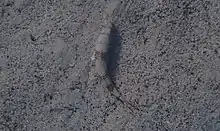Upeneus pori
Upeneus pori (Por's goatfish) is a species of marine ray-finned fish, a goatfish from the family Mullidae which is found in western Indian Ocean and the eastern Mediterranean Sea.
| Upeneus pori | |
|---|---|
 | |
| Scientific classification | |
| Domain: | Eukaryota |
| Kingdom: | Animalia |
| Phylum: | Chordata |
| Class: | Actinopterygii |
| Order: | Perciformes |
| Family: | Mullidae |
| Genus: | Upeneus |
| Species: | U. pori |
| Binomial name | |
| Upeneus pori Ben-Tuvia & Golani, 1989 | |
Description
Upeneus pori has an elongated body and a rounded snout.[2] The body is greyish or red-brown, darker on the back, and covered with grey or reddish brown spots which go as far as the lower flanks but with no or a very faint lateral stripe visible in freh specimens. There is a dark brown or red bar which runs vertically through the eye and the barbels located on the chin are white or yellow. The first dorsal fin is colourless. The caudal fin is marked with a total of 11–15 bars with 4–6 reddish brown bars on the upper lobe and 6–9 red-brown or grey bars on the lower part of the lower lobe which extend to form a broad brown or dark grey stripe along middle of lobe. There are also 3–4 brownish-red or grey bars on inner, upper half of lower lobe, these bars are normally visible on preserved specimens. The dorsal fins have a total of 7 spines and 9 soft rays while the anal fin has a single spine and 7 soft rays.[3] This fish attains a standard length of 19 centimetres (7.5 in).[4]
Distribution
Upeneus pori occurs naturally in the Red Sea and into the north western Indian Ocean as far east as the southern coast of Oman. It has also been found off Madagascar in the southwestern Indian Ocean.[4] It is now very abundant in the eastern Mediterranean Sea where it was recorded as early as 1950, following its migration through the Suez Canal, and has spread recently as far west as Tunisia and Sicily.[5][6]
Habitat and biology
Upeneus pori feeds on benthic invertebrates buried in the substrate, particularly crustaceans and, somewhat on polychaetes. They use their barbels, like other goatfishes, to detect prey.[3] In the Mediterranean its spawning season lasts from April to September.
Taxonomy and etymology
Upeneus pori was first formally described in 1989 by Adam Ben Tuvia and Daniel Golani with the type locality given as Eilat on the Gulf of Aqaba and was subsequently found to occur in the eastern Mediterranean Sea.[7] The authors honoured the hydrobiologist and biogeographer Francis Dov Por (1927-2014) of the Hebrew University of Jerusalem in recognition of contribution to the study of Lessepsian migration, of which U.pori is part.[8]
U. pori is a member of the japonicus species group within the genus Upeneus along with U. asymmetricus, U. australasiae, U. farnis, U. francisi, U. guttatus, U. japonicus, U. itoui, U. lombo, U. parvus, U. spottocaudalis and U. torres .[4][9][10]
References
- Uiblein, F.; Everett, B.; Maunde, C.; Matiku, P.; Sithole, Y. (2020). "Upeneus pori". IUCN Red List of Threatened Species. 2020: e.T18177504A151597428. doi:10.2305/IUCN.UK.2020-2.RLTS.T18177504A151597428.en. Retrieved 11 March 2022.
- M.L. Geraci; D. Scannella; F. Falsone; et al. (2018). "Preliminary study on the biological traits of the Por's goatfish Upeneus pori (Chordata: Actinopterygii) off the southern coast of Lampedusa Island (Central Mediterranean)". The European Zoological Journal. 85 (1). doi:10.1080/24750263.2018.1464218.
- Froese, Rainer; Pauly, Daniel (eds.) (2019). "Upeneus pori" in FishBase. December 2019 version.
- Franz Uiblein & Philip C. Heemstra (2009). "A taxonomic review of the Western Indian Ocean goatfishes of the genus Upeneus (Family Mullidae), with descriptions of four new species". Smithiana. 11: 35–71.
- Atlas of Exotic Fishes in the Mediterranean Sea (Upeneus pori). 2nd Edition. 2021. 366p. CIESM Publishers, Paris, Monaco.https://ciesm.org/atlas/fishes_2nd_edition/Upeneus_pori.pdf
- Ertan Taskavak & Murat Bilecenoglu (2001). "Length–weight relationships for 18 Lessepsian (Red Sea) immigrant fish species from the eastern Mediterranean coast of Turkey". Journal of the Marine Biological Association of the United Kingdom. 81 (5): 895–896. doi:10.1017/S0025315401004805.
- Eschmeyer, William N.; Fricke, Ron & van der Laan, Richard (eds.). "Upeneus pori". Catalog of Fishes. California Academy of Sciences. Retrieved 8 April 2020.
- Christopher Scharpf & Kenneth J. Lazara (2 January 2020). "Order SYNGNATHIFORMES: Families DACTYLOPTERIDAE, PEGASIDAE, CALLIONYMIDAE, DRACONETTIDAE and MULLIDAE". The ETYFish Project Fish Name Etymology Database. Christopher Scharpf and Kenneth J. Lazara. Retrieved 8 April 2020.
- Masahiri Yamashita; Daniel Golani; Hiroyuki Motomura (2011). "A new species of Upeneus (Perciformes: Mullidae) from southern Japan". Zootaxa. 3107 (1): 47–58. doi:10.11646/zootaxa.3107.1.3.
- Franz Uiblein; Daniel Gledhill & Teguh Peristiwady (2017). "Two new goatfishes of the genus Upeneus (Mullidae) from Australia and Indonesia". Zootaxa. 4318 (2): 295–311. doi:10.11646/zootaxa.4318.2.4.
